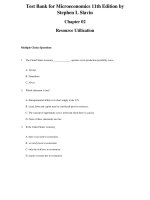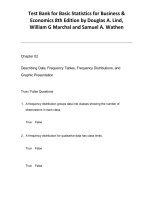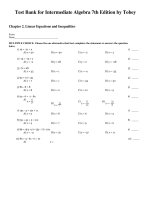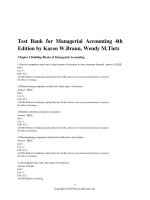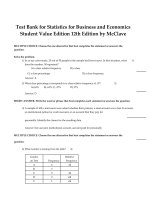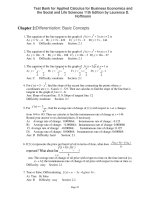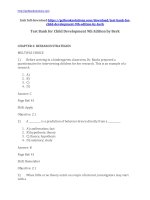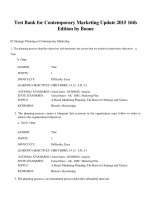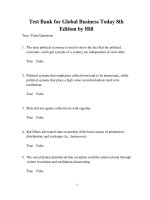Link full download test bank for child development 9th edition by berk
Bạn đang xem bản rút gọn của tài liệu. Xem và tải ngay bản đầy đủ của tài liệu tại đây (667.19 KB, 52 trang )
Test Bank for Child Development 9th Edition by Berk
CHAPTER 2: RESEARCH STRATEGIES
MULTIPLE CHOICE
1)
Before arriving in a kindergarten classroom, Dr. Banks prepared a
questionnaire for interviewing children for her research. This is an
example of a research
1.
2.
3.
4.
A)
B)
C)
D)
Answer: C
Page Ref: 41
Skill: Apply
Objective: 2.1
2)
A __________ is a prediction of behavior drawn directly from a __________.
1.
2.
3.
4.
A) confirmation; fact
B) hypothesis; theory
C) theory; hypothesis
D) summary; study
Answer: B
Page Ref: 41
Skill: Remember
Objective: 2.1
3)
When little or no theory exists on a topic of interest, investigators may
start with a
1. A) research question.
2. B) developmental inquiry.
3. C) research design.
4. D) research method.
Answer: A
Page Ref: 42
Skill: Understand
Objective: 2.1
4)
Dr. Jenka wonders if the U.S. wars in Iraq and Afghanistan have heightened
children’s fears and anxieties. This is an example of a
1.
2.
3.
4.
A)
B) research method.
C)
D) research question.
Answer: D
Page Ref: 42
Skill: Apply
Objective: 2.1
5)
A strength of __________ is that it reflects participants’ everyday behavior.
1.
2.
3.
4.
A) structured observation
B) naturalistic observation
C) the structured interview
D) the clinical interview
Answer: B
Page Ref: 43
Skill: Remember
Objective: 2.2
6)
Dr. Shigoka is interested in determining which central nervous system
structures contribute to personality development. Dr. Shigoka will likely
use
1.
2.
3.
4.
A) neurobiological methods.
B) event sampling.
C) the clinical, or case study, method.
D)
Answer: A
Page Ref: 43
Skill: Apply
Objective: 2.2
7)
Which of the following is a major limitation of neurobiological methods?
1. A) Researchers cannot control the conditions under which participants are
studied.
2. B) The accuracy of the results may be reduced by observer bias.
3. C) Many factors besides those of interest to the researcher can influence a
physiological response.
4. D) It reveals with certainty the meaning of autonomic or brain activity.
Answer: C
Page Ref: 43
Skill: Understand
Objective: 2.2
8)
Dr. Lector provides a full picture of a convicted criminal’s psychological
functioning by combining interviews, observations, test scores, and
neurobiological assessments. Which of the following information-gathering
methods is Dr. Lector likely using?
1.
2.
3.
4.
A) naturalistic observation
B) longitudinal research design
C) the clinical, or case study, method
D) ethnography
Answer: C
Page Ref: 43
Skill: Apply
Objective: 2.2
9)
In __________, findings cannot be applied to individuals other than the
participant.
1.
2.
3.
4.
A) structured observation
B) a clinical interview
C) the clinical, or case study, method
D) naturalistic observation
Answer: C
Page Ref: 43
Skill: Remember
Objective: 2.2
10)
1.
2.
3.
4.
An investigator is interested in capturing a culture’s unique values and
social processes. __________ is best-suited for this type of study.
A) The clinical interview
B) Naturalistic observation
C) Ethnography
D) The clinical, or case study, method
Answer: C
Page Ref: 43
Skill: Remember
Objective: 2.2
11)
One major limitation of the ethnographic method is
1. A) it does not reveal a depth of information.
2. B) findings cannot be applied to individuals and settings other than the ones
studied.
3. C) participant responses are subject to inaccurate reporting.
4. D) it does not reveal the participants’ behavior in everyday life.
Answer: B
Page Ref: 43
Skill: Understand
Objective: 2.2
12)
1.
2.
3.
4.
Marilyn wants to know how preschool children react to aggressive peers.
To study their behavior, Marilyn will probably use
A) clinical interviews.
B)
C) the clinical, or case study, method.
D) naturalistic observation.
Answer: D
Page Ref: 43
Skill: Apply
Objective: 2.2
13)
Which of the following is a major limitation of naturalistic observation?
1. A) For each participant, responses may differ due to the manner of
interviewing.
2. B) Researchers cannot expect that participants will behave in the laboratory
as they do in their natural environments.
3. C) Findings cannot be generalized beyond the participants and settings in
which the research was originally conducted.
4. D) Not all participants have the same opportunity to display a particular
behavior in everyday life.
Answer: D
Page Ref: 43
Skill: Understand
Objective: 2.2
14)
1.
2.
3.
4.
In __________, every participant has an equal opportunity to display the
response of interest.
A) structured observation
B) field experiments
C) clinical interviews
D) event sampling
Answer: A
Page Ref: 44
Skill: Remember
Objective: 2.2
15)
1.
2.
3.
4.
__________ permits greater control over the research situation than does
__________.
A) Naturalistic observation; the clinical, or case study, method
B) Structured observation; naturalistic observation
C) Naturalistic observation; a structured interview
D) Naturalistic observation; a questionnaire
Answer: B
Page Ref: 44
Skill: Remember
Objective: 2.2
16)
1.
2.
3.
4.
__________ is especially useful for studying behaviors that investigators
rarely have an opportunity to see in everyday life.
A) Structured observation
B) Naturalistic observation
C) The structured interview
D) The clinical, or case study, method
Answer: A
Page Ref: 44
Skill: Remember
Objective: 2.2
17)
1.
2.
3.
4.
When researchers need information on only one or a few kinds of behavior,
an efficient procedure is
A) the clinical, or case study, method.
B) neurobiological sampling.
C) event sampling.
D)
Answer: C
Page Ref: 44
Skill: Remember
Objective: 2.2
18)
1.
2.
3.
4.
In event sampling, the observer records
A) all instances of a particular behavior during a specified time period.
B) all behaviors that occur during a specified time period.
C) whether certain behaviors occur during a sample of short time intervals.
D) similar behavior patterns in participants who are the same age.
Answer: A
Page Ref: 44
Skill: Remember
Objective: 2.2
19)
In time sampling, the observer records
1. A) all instances of a particular behavior during a specified time period.
2. B) all behaviors that occur during a specified time period.
3. C) whether certain behaviors occur during a sample of short intervals.
4. D) similar behavior patterns in participants who are the same age.
Answer: C
Page Ref: 45
Skill: Remember
Objective: 2.2
20)
1.
2.
3.
4.
Dr. Ramirez examined 100 brother–sister pairs for 10 minutes each, noting
on a checklist the behaviors that occurred during 20 thirty-second
intervals. This is an example of
A) event sampling.
B) time sampling.
C) a naturalistic observation.
D) a genetic experiment.
Answer: B
Page Ref: 45
Skill: Apply
Objective: 2.2
21)
1.
2.
3.
4.
A major problem with systematic observation is
A) practice effects.
B) selective attrition.
C) biased sampling.
D) observer influence.
Answer: D
Page Ref: 45
Skill: Remember
Objective: 2.2
22)
For children under age 7 or 8, observer influence is
1.
2.
3.
4.
A) impossible to minimize.
B) usually present for the first 10 to 12 sessions.
C) generally limited to the first session or two.
D) rarely a concern.
Answer: C
Page Ref: 45
Skill: Remember
Objective: 2.2
23)
To minimize observer influence, researchers can
12. A) limit their observations to children over the age of 12.
13. B) tell participants what they are trying to study.
14. C) ask individuals who are part of the child’s natural environment to do the
observing.
15. D) tell participants that they must be serious and behave in a natural way.
Answer: C
Page Ref: 45
Skill: Understand
Objective: 2.2
24)
1.
2.
3.
4.
Because Dr. Frederickson’s students are aware of the purposes of a study,
they may see and record what they expect to see rather than what the
participants actually do. This is known as
A) event influence.
B) observer bias.
C) a cohort effect.
D) internal validity.
Answer: B
Page Ref: 45
Skill: Apply
Objective: 2.2
25)
__________ are best suited to collect systematic observations.
1. A) Trained investigators
2. B) People who have little personal investment in the investigator’s
hypotheses
3. C) Parents and caregivers
4. D) People who know and understand the investigator’s hypotheses
Answer: B
Page Ref: 45
Skill: Understand
Objective: 2.2
26)
1.
2.
3.
4.
When studying children’s thinking, Piaget used
A) naturalistic observations.
B) event and time sampling procedures.
C) the clinical, or case study, method.
D) relatively unstructured clinical interviews.
Answer: D
Page Ref: 46
Skill: Remember
Objective: 2.2
27)
1.
2.
3.
4.
A researcher interested in children’s beliefs about God begins each
interview with the same question, but subsequent questions are
determined by the child’s individual answers. This is an example of a
A) clinical interview.
B) data questionnaire.
C) structured interview.
D) case study.
Answer: A
Page Ref: 46
Skill: Apply
Objective: 2.2
28)
A major strength of the clinical interview is that it
1. A) permits people to display their thoughts in terms that are as close as
possible to the way they think in everyday life.
2. B) provides highly objective data that can be generalized to a larger
population.
3. C) accurately assesses participants who have low verbal ability and
expressiveness.
4. D) assures that each participant is asked the same set of questions.
Answer: A
Page Ref: 46
Skill: Understand
Objective: 2.2
29)
1.
2.
3.
4.
Which of the following is a strength of the clinical interview?
A) It is accurate with respect to the participants’ thoughts and experiences.
B) It can provide a large amount of information in a fairly brief period.
C) It permits comparisons of participants’ responses.
D) It is not subject to observer influence or observer bias.
Answer: B
Page Ref: 46
Skill: Understand
Objective: 2.2
30)
Which of the following is a major limitation of the clinical interview?
1. A) Participants may make up answers that do not represent their actual
thinking.
2. B) It does not provide much insight into participants’ reasoning or ideas.
3. C) The questions are phrased the same for each participant, regardless of
their comprehension.
4. D) It overestimates participants’ intellectual capacities.
Answer: A
Page Ref: 46
Skill: Understand
Objective: 2.2
31)
1.
2.
3.
4.
Clinical interviews that focus on __________ are particularly vulnerable to
distortion.
A) current information and specific characteristics
B) past information and specific characteristics
C) past information and global judgments
D) current information and global judgments
Answer: C
Page Ref: 46
Skill: Remember
Objective: 2.2
32)
A structured interview
1. A) yields a greater depth of information than does a clinical interview. 2. B) is
too flexible and, therefore, yields too wide a variety of responses.
3. C) is more time consuming to conduct than is a clinical interview.
4. D) eliminates the possibility that an interviewer might press and prompt
some participants more than others.
Answer: D
Page Ref: 47
Skill: Understand
Objective: 2.2
33)
A researcher is likely to choose a structured interview over a clinical
interview when he or she
1. A) is interested in more in-depth answers.
2. B) is concerned that observer influence might bias the findings.
3. C) plans to obtain written responses from an entire group of participants at
the same time.
4. D) is interested in obtaining sensitive information about the participant.
Answer: C
Page Ref: 47
Skill: Understand
Objective: 2.2
34)
1.
2.
3.
4.
Dr. Quinn uses neurobiological methods. She is interested in studying the
relationship between __________ and __________.
A) genes; the environment
B) developmental functions; individual differences
C) neurological maladies; biological processes
D) nervous system processes; behavior
Answer: D
Page Ref: 47
Skill: Apply
Objective: 2.2
35)
Neurobiological methods
1. A) are affected by inaccurate reporting.
2. B) help researchers infer the perceptions, thoughts, and emotions of infants.
3. C) do not show which nervous system structures contribute to individual
differences.
4. D) bring together a wide range of information on one child, including
interviews, observations, and test scores.
Answer: B
Page Ref: 47
Skill: Understand
Objective: 2.2
36)
1.
2.
3.
4.
The two most frequently used measures of brain functioning, __________ and
__________, detect electric activity in the cerebral cortex.
A) EEG; fMRI
B) PET; ERPs
C) EEG;ERPs
D) fMRI; NIRS
Answer: C
Page Ref: 48
Skill: Remember
Objective: 2.2
37)
1.
2.
3.
4.
In an electroencephalogram (EEG), researchers
A) examine brain-wave patterns for stability and organization.
B) detect the general location of brain-wave activity.
C) take three-dimensional computerized pictures of the entire brain.
D) beam infrared light at the brain.
Answer: A
Page Ref: 48
Skill: Remember
Objective: 2.2
38)
Dr. Thompson uses an EEG to record the frequency and amplitude of brain
waves in response to music in multiple areas of the cerebral cortex. Dr.
Thompson is using
1. A) functional magnetic resonance imaging (fMRI).
2. B) positron emission tomography (PET).
3. C) near-infrared spectroscopy (NIRS).
4. D) event-related potentials (ERPs).
Answer: D
Page Ref: 48
Skill: Apply
Objective: 2.2
39)
In a series of studies on infants of diabetic mothers, Charles Nelson and his
collaborators used __________ to assess young infants’ memory performance.
1. A) NIRS
2. B) ERPs
3. C) PET
4. D) fMRI
Answer: B
Page Ref: 49 Box: BIOLOGY AND ENVIRONMENT: Prenatal Iron Deficiency and
Memory Impairments in Infants of Diabetic Mothers: Finding of ERP Research
Skill: Remember
Objective: 2.2
40)
Which of the following is a finding of Charles Nelson’s studies on infants of
diabetic mothers?
1. A) As a result of iron depletion in critical brain areas, a diabetic pregnancy
places the fetus at risk for lasting memory deficits.
2. B) Early memory deficiencies found in infants of diabetic mothers are
shortlived and do not last into the preschool years.
3. C) Infants of diabetic mothers responded to novel objects with a stronger
temporal-lobe slow wave than did control babies.
4. D) Infants of diabetic mothers were more likely than control babies to
recognize their mother’s facial image.
Answer: A
Page Ref: 49 Box: BIOLOGY AND ENVIRONMENT: Prenatal Iron Deficiency and
Memory Impairments in Infants of Diabetic Mothers: Findings of ERP Research
Skill: Understand
Objective: 2.2
41)
1.
2.
3.
4.
Because __________ and __________ require that the participant lie as
motionless as possible for an extended time, they are not suitable for
infants and young children.
A) EEG; PET
B) ERPs; fMRI
C) NIRS; PET
D) PET; fMRI
Answer: D
Page Ref: 50
Skill: Remember
Objective: 2.2
42)
1.
2.
3.
4.
A neuroimaging technique that works well in infancy and early childhood
is
A) event-related potentials (ERPs).
B) near-infrared spectroscopy (NIRS).
C) functional magnetic resonance imaging (fMRI).
D) positron emission tomography (PET).
Answer: B
Page Ref: 50
Skill: Remember
Objective: 2.2
43)
Which of the following research methods is an outgrowth of psychoanalytic
theory?
1. A) naturalistic observation
2. B) structured observation
3. C) ethnography
4. D) the clinical, or case study, method
Answer: D
Page Ref: 50
Skill: Understand
Objective: 2.2
44)
1.
2.
3.
4.
Which of the following research methods would be the best suited for
studying child prodigies?
A) structured interviews
B) questionnaires
C) the clinical, or case study, method
D) ethnography
Answer: C
Page Ref: 51
Skill: Understand
Objective: 2.2
45)
1.
2.
3.
4.
A strength of __________ is that it yields richly detailed case narratives that
offer valuable insights into the many factors affecting development.
A) the clinical, or case study, method
B) ethnography
C) naturalistic observation
D) structured observation
Answer: A
Page Ref: 51
Skill: Remember Objective:
2.2
46)
Which of the following is a limitation of the clinical, or case study, method?
1. A) Investigators cannot assume that their conclusions apply, or generalize, to
anyone other than the individual studied.
2. B) Information collected often lacks descriptive detail.
3. C) It does not provide evidence about the individual’s current functioning.
4. D) It requires intensive study of participants’ moment-by-moment behaviors.
Answer: A
Page Ref: 51
Skill: Understand
Objective: 2.2
47)
Unlike the clinical, or case study, method, ethnographic research
1. A) is easily biased by the researcher’s beliefs.
2. B) is aimed at understanding a single individual.
3. C) is a descriptive technique.
4. D) relies on participant observation.
Answer: D
Page Ref: 52
Skill: Understand
Objective: 2.2
48)
1.
2.
3.
4.
To study parental warmth in the Ethiopian culture, Dr. Jolie moves in with
a family in an Ethiopian village. Which of the following informationgathering methods of research is Dr. Jolie using?
A) ethnography
B) the clinical, or case study, method
C) neurobiological methods
D) structured observation
Answer: A
Page Ref: 52
Skill: Apply
Objective: 2.2
49)
1.
2.
3.
4.
Nearly one-fourth of U.S. children
A) were born in Latin America.
B) were born in Asia.
C) have foreign-born parents.
D) are illegal aliens.
Answer: C
Page Ref: 53 Box: CULTURAL INFLUENCES: Immigrant Youths: Adapting to a New
Land
Skill: Remember
Objective: 2.2
50)
In North America, students who are first-generation and secondgeneration
1. A) are more likely than students of native-born parents to commit delinquent
and violent acts.
2. B) are more likely than students of native-born parents to use drugs and
alcohol.
3. C) generally have lower self-esteem than students of native-born parents.
4. D) often achieve in school as well as or better than students of native-born
parents.
Answer: D
Page Ref: 53: Box: CULTURAL INFLUENCES: Immigrant Youths: Adapting to a New
Land
Skill: Understand
Objective: 2.2
51)
Ethnographies reveal that immigrant parents view __________ as the surest
way to improve life chances.
1. A) high socioeconomic status
2. B) education
3. C) speaking English in the home
4. D) severing ties with an ethnic community
Answer: B
Page Ref: 53 Box: CULTURAL INFLUENCES: Immigrant Youths: Adapting to a New
Land
Skill: Remember
Objective: 2.2
52)
1.
2.
3.
4.
Both __________ and __________ protect immigrant youths from delinquency,
early pregnancy, drug use, and other risky behaviors.
A) family relationships; school achievement
B) collectivist values; extracurricular involvement
C) acculturation; assimilation
D) individualistic values; opportunities for peer mentoring
Answer: A
Page Ref: 53 Box: CULTURAL INFLUENCES: Immigrant Youths: Adapting to a New
Land
Skill: Remember
Objective: 2.2
53)
1.
2.
3.
4.
Immigrant parents of successful youths typically
A) do not share their children’s views on the importance of education.
B) stress individual goals over allegiance to family and community.
C) develop close ties to an ethnic community.
D) allow their children to monitor themselves.
Answer: C
Page Ref: 53 Box: CULTURAL INFLUENCES: Immigrant Youths: Adapting to a New
Land
Skill: Understand
Objective: 2.2
54)
1.
2.
3.
4.
To be __________, observations and evaluations of people’s actions cannot be
unique to a single observer.
A) internally valid
B) generalizeable
C) reliable
D) externally valid
Answer: C
Page Ref: 54
Skill: Remember
Objective: 2.3
55)
1.
2.
3.
4.
An intelligence test has high reliability if
A) it accurately predicts children’s academic performance in school.
B) it yields similar results when given twice within a short period of time.
C) the content of the test is related to theoretical models of intelligence.
D) it is correlated with other established measures of intelligence.
Answer: B
Page Ref: 54
Skill: Understand
Objective: 2.3
56)
Professor Nagini developed a measure to rate children’s fears. To test
interrater reliability, he
1. A) compared the level of agreement between two different observers who
used his measure simultaneously.
2. B) used people who were part of children’s natural environment to do the
rating.
3. C) compared the degree to which children from different cohorts scored
similarly.
4. D) compared the extent to which his measure correlated with neurobiological
measures of distress.
Answer: A
Page Ref: 54
Skill: Apply
Objective: 2.3
57)
1.
2.
3.
4.
Dr. Sums developed a test of mathematical ability. To measure __________, he
split the test in two and compared children’s responses on both halves.
A) inter-rater reliability
B) test–retest reliability
C) internal validity
D) external validity
Answer: B
Page Ref: 54
Skill: Apply
Objective: 2.3
58)
Which of the following procedures can be used to determine the reliability
of ethnographic and clinical studies?
1. A) Responses to the same measures can be compared on separate occasions.
2. B) Researchers can measure the quantitative scores yielded by these two
methods.
3. C) Answers on different halves of the same measure can be compared by
judges.
4. D) Judges can see if they agree with the researcher that the patterns and
themes identified are grounded in evidence and are plausible.
Answer: D
Page Ref: 54
Skill: Understand
Objective: 2.3
59)
For research methods to have high validity,
1. A) they must yield consistent results over time.
2. B) observations cannot be unique to a single observer.
3. C) they must accurately measure characteristics that the researchers set out
to measure.
4. D) the participants’ responses must be similar when the same measures are
given on a different occasion.
Answer: C
Page Ref: 54
Skill: Remember
Objective: 2.3
60)
Ms. Allan developed a test intended to measure eighth-grade children’s
knowledge of mathematics. Although children who took the new test twice
received similar scores on both occasions, the test contained only
multiplication problems. Ms. Allan’s test has __________ reliability and
__________ validity.
1. A) high; low
2. B) low; low
3. C) high; high
4. D) low; high
Answer: A
Page Ref: 54
Skill: Apply
Objective: 2.3
61)
1.
2.
3.
4.
One way to assess the validity of a new measure of second-grade children’s
mathematical knowledge is to
A) compare the children’s answers on different halves of the same test.
B) test for inter-rater reliability.
C) compare the children’s answers on different forms of the same measure.
D) compare the children’s scores with how well they do on their math
assignments in school.
Answer: D
Page Ref: 54–55
Skill: Apply
Objective: 2.3
62)
1.
2.
3.
4.
If, during any phase of an investigation, participants’ behavior is influenced
by factors unrelated to the hypothesis, then the __________ of the study is in
doubt.
A) inter-rater reliability
B) test–retest reliability
C) internal validity
D) external validity
Answer: C
Page Ref: 55
Skill: Remember
Objective: 2.3
63)
1.
2.
3.
4.
Ensuring that samples, tasks, and contexts for conducting research
represent the real-world people and situations that the investigator aims to
understand is key to
A) inter-rater reliability.
B) test–retest reliability.
C) internal validity.
D) external validity.
Answer: D
Page Ref: 55
Skill: Remember
Objective: 2.3
64)
The two main designs used in all research on human behavior are __________
and __________.
1.
2.
3.
4.
A) correlational; coefficient
B) correlational; experimental
C) dependent; independent
D) laboratory; field experiments
Answer: B
Page Ref: 55
Skill: Remember
Objective: 2.4
65)
In a correlational design, researchers
1. A) gather information on individuals, generally in natural life circumstances,
and make no effort to alter their experiences.
2. B) use an evenhanded procedure to assign people to two or more treatment
conditions.
3. C) can infer cause and effect.
4. D) manipulate changes in the independent variable.
Answer: A
Page Ref: 55
Skill: Understand
Objective: 2.4
66)
A major limitation of correlational studies is that
1. A) researchers cannot study how conditions of interest currently exist.
2. B) researchers cannot infer cause and effect.
3. C) there is no way to measure the strength of a positive relationship between
variables.
4. D) negative relationships between variables cannot be measured.
Answer: B
Page Ref: 55
Skill: Understand
